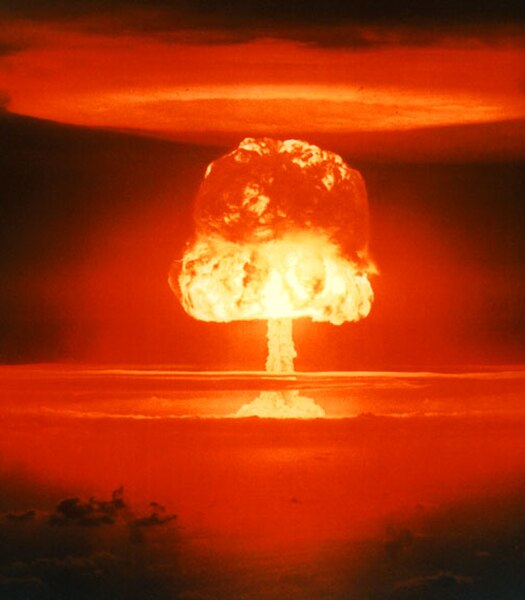The Tsar Bomba, also known by the alphanumerical designation "AN602", was a thermonuclear aerial bomb, and the most powerful nuclear weapon ever created and tested. The Soviet physicist Andrei Sakharov oversaw the project at Arzamas-16, while the main work of design was by Sakharov, Viktor Adamsky, Yuri Babayev, Yuri Smirnov, and Yuri Trutnev. The project was ordered by Nikita Khrushchev in July 1961 as part of the Soviet resumption of nuclear testing after the Test Ban Moratorium, with the detonation timed to coincide with the 22nd Congress of the Communist Party of the Soviet Union.
A Tsar Bomba-type casing on display at the Sarov atomic bomb museum, Sarov
The Tsar Bomba's fireball, about 8 km (5.0 mi) wide at its maximum, was prevented from touching the ground by the shock wave, but reached nearly 10.5 km (6.5 mi) in the sky – the altitude of the deploying bomber.
The mushroom cloud of Tsar Bomba seen from a distance of 161 km (100 mi). The crown of the cloud is 65 km (40 mi) high at the time of the picture. (source: Rosatom State Corporation Communications Department 20–08–2020)
A thermonuclear weapon, fusion weapon or hydrogen bomb (H bomb) is a second-generation nuclear weapon design. Its greater sophistication affords it vastly greater destructive power than first-generation nuclear bombs, a more compact size, a lower mass, or a combination of these benefits. Characteristics of nuclear fusion reactions make possible the use of non-fissile depleted uranium as the weapon's main fuel, thus allowing more efficient use of scarce fissile material such as uranium-235 or plutonium-239. The first full-scale thermonuclear test was carried out by the United States in 1952 and the concept has since been employed by most of the world's nuclear powers in the design of their weapons.
Edward Teller in 1958
Operation Castle thermonuclear test, Castle Romeo shot
Operation Grapple on Christmas Island was the first British hydrogen bomb test.
One of France's Triomphant-class nuclear-armed submarines, Le Téméraire (S617)







